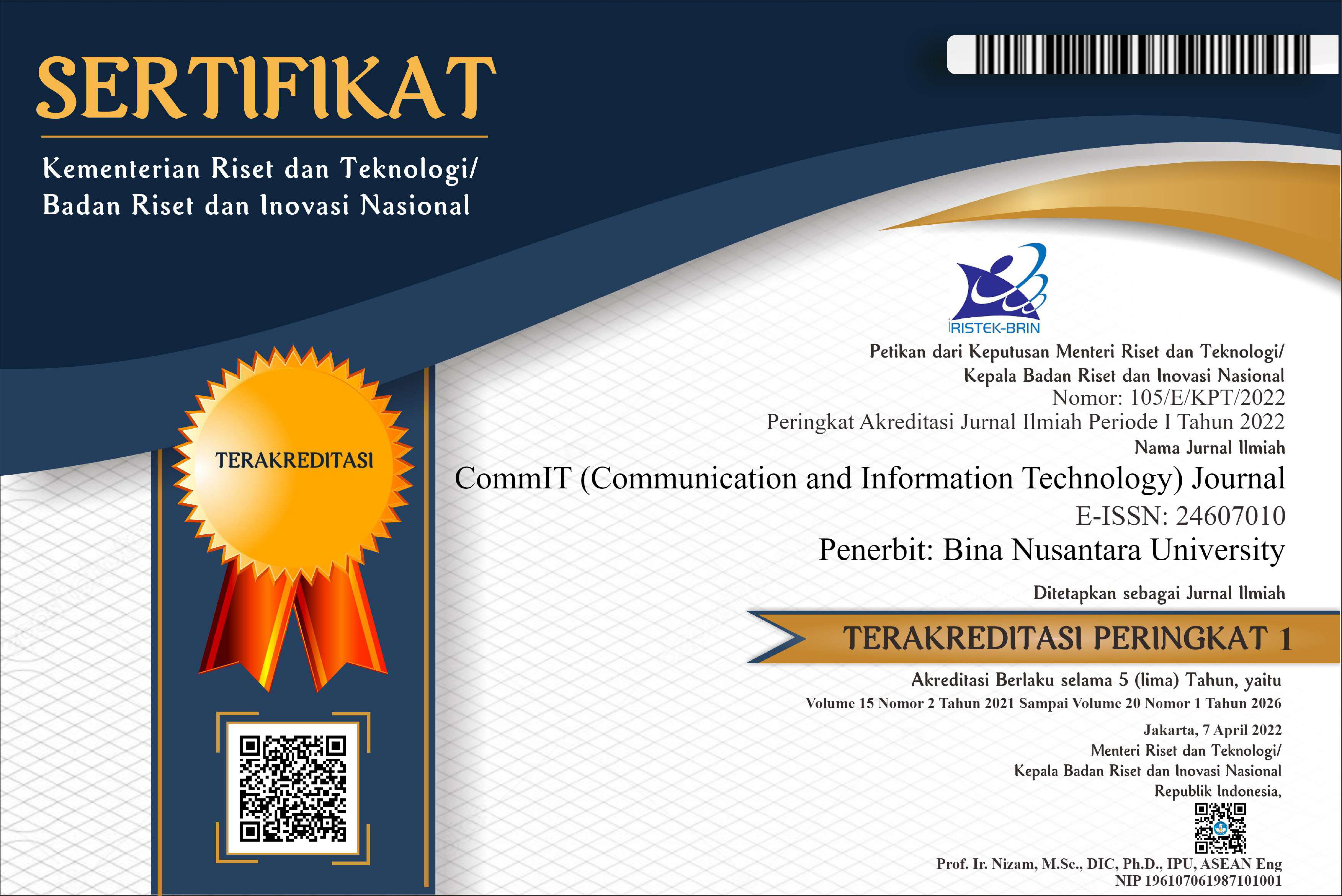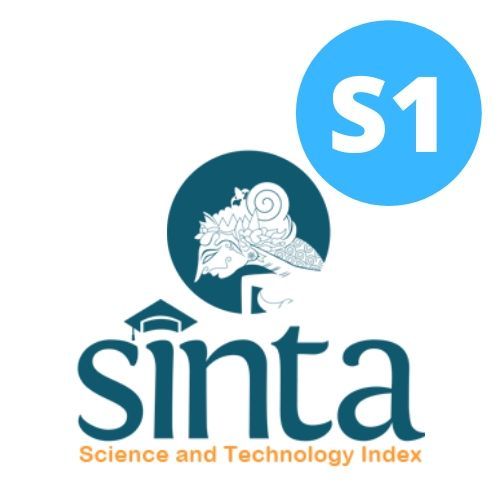Mapping Irrigation Networks with Geographical Information Systems Using Satelite Imagery Data: A Case of Brebes Regency, Indonesia
DOI:
https://doi.org/10.21512/commit.v13i1.5075Keywords:
Satellite Imagery Data, Geographic Information System (GIS), Irrigation NetworkAbstract
Water resources are important factors in food production. Those are very vital and strategic to meet food needs and food security. As water is scarce both in terms of volume and distribution throughout the year, reliable water management is needed. To support this water management, the accurate data is needed. However, the complete tabular data is not enough. It is because the existing tabular data does not provide the various activities and events based on time and place spatially and detail enough for planning purposes at the sub-district level. The researchers use high-resolution satellite imagery data that have been pre-processed with the geometric and radiometric corrections. They are used as one of the layers in the working map, so it is easier to provide the depiction of irrigation network objects, to find out the location of rice fields that have not been irrigated and the location of damaged irrigation networks. The depiction of the working map can also be used to map irrigation networks and their network conditions. Through this work, it has been shown that the researchers can map irrigation networks in detail for operational planning at a sub-district level with the help of technology, in particular for developing countries that is difficult or even impossible to do in the past.
Plum Analytics
References
B. Juanda, “Rancang bangun sistem insentif untuk meningkatkan pendapatan petani, efisiensi penggunaan air dan ketahanan pangan,” Jurnal Ilmu Pertanian Indonesia, vol. 17, no. 2, pp. 83–89, 2014.
Kementerian Lingkungan Hidup dan Kehutanan, “Statistik Kementerian Lingkungan Hidup dan Kehutanan tahun 2015,” 2015. [Online]. Available: http://www.menlhk.go.id/downlot.php?file=Statistik KLHK tahun 2015.pdf
Kementerian Pertanian Republik Indonesia, “Statistik data lahan pertanian tahun 2012-2016,” 2017. [Online]. Available: http://epublikasi.setjen.pertanian.go.id/arsip-perstatistikan/167-statistik/statistik-lahan/450-statistik-data-lahan-pertanian-tahun-2012-2016
E. T. Opa, “Analisis perubahan luas lahan mangrove di kabupaten Pohuwato propinsi Gorontalo dengan menggunakan citra Landsat,” Jurnal Perikanan dan Kelautan Tropis, vol. 6, no. 2, pp.79–82, 2010.
C. Ohrt, K. W. Roberts, H. J. Sturrock, J. Wegbreit, B. Y. Lee, and R. D. Gosling, “Information systems to support surveillance for malaria elimination,” The American Journal of Tropical Medicine and Hygiene, vol. 93, no. 1, pp. 145–152, 2015.
G. M. Aji and S. Suwardo, “Buku data daerah irigasi Cilaca studi kasus kegiatan magang di Dinas Bina Marga, Sumber Daya Air, Energi, dan Sumber Daya Mineral Kabupaten Cilacap,” Ph.D. dissertation, Universitas Gadjah Mada, 2014.
X. Zhu, W. Zhu, J. Zhang, and Y. Pan, “Mapping irrigated areas in China from remote sensing and statistical data,” IEEE Journal of Selected Topics in Applied Earth Observations and Remote Sensing, vol. 7, no. 11, pp. 4490–4504, 2014.
G. Massei, L. Rocchi, L. Paolotti, S. Greco, and A. Boggia, “Decision support systems for environmental management: A case study on wastewater from agriculture,” Journal of Environmental Management, vol. 146, pp. 491–504, 2014.
N. Hayati and M. Taufik, “Kajian ketelitian planimetris citra resolusi tinggi pada Google Earth untuk pembuatan peta dasar skala 1:10000 kecamatan Banjar Timur Kota Banjarmasin,” Geoid, vol. 7, no. 1, pp. 52–57, 2018.
J. Fox and J. B. Vogler, “Land-use and land-cover change in montane mainland Southeast Asia,” Environmental Management, vol. 36, no. 3, pp. 394–403, 2005.
A. Shalaby and R. Tateishi, “Remote sensing and GIS for mapping and monitoring land cover and land-use changes in the northwestern coastal zone of Egypt,” Applied Geography, vol. 27, no. 1, pp. 28–41, 2007.
T. N. Carlson and S. T. Arthur, “The impact of land useland cover changes due to urbanization on surface microclimate and hydrology: A satellite perspective,” Global and Planetary Change, vol. 25, no. 1–2, pp. 49–65, 2000.
A. M. Dewan and Y. Yamaguchi, “Land use and land cover change in Greater Dhaka, Bangladesh: Using remote sensing to promote sustainable urbanization,” Applied Geography, vol. 29, no. 3, pp. 390–401, 2009.
Y. Du, P. M. Teillet, and J. Cihlar, “Radiometric normalization of multitemporal high-resolution satellite images with quality control for land cover change detection,” Remote Sensing of Environment, vol. 82, no. 1, pp. 123–134, 2002.
Z. Zhang, X. Wang, X. Zhao, B. Liu, L. Yi, L. Zuo, Q. Wen, F. Liu, J. Xu, and S. Hu, “A 2010 update of national land use/cover database of China at 1:100000 scale using medium spatial resolution satellite images,” Remote Sensing of Environment, vol. 149, pp. 142–154, 2014.
S. H. Lee, Y. S. Choi, R. Lee, G. S. Park, and E. K. Hong, “A decision support system for scientists by processing large-scale satellite images on a distributed computing environment,” Multimedia Tools and Applications, vol. 77, no. 11, pp. 14 305–14 326, 2018.
B. Rudianto, “Analisis pengaruh sebaran ground control point terhadap ketelitian objek pada peta citra hasil ortorektifikasi,” Jurnal Itenas Rekayasa, vol. 15, no. 1, pp. 11–18, 2011.
T. Hashimoto and S. Murai, “Geometric correction of NOAA AVHRR imagery in accordance with the number of GCPs,” Journal of the Japan Society of Photogrammetry and Remote Sensing, vol. 32, no. 5, pp. 13–18, 1993.
Indarto, Pengindraan jauh metode analisis dan interpretasi citra satelit. Yogyakarta: Penerbit Andi, 2017.
Downloads
Published
Issue
Section
License
Authors who publish with this journal agree to the following terms:
a. Authors retain copyright and grant the journal right of first publication with the work simultaneously licensed under a Creative Commons Attribution License - Share Alike that allows others to share the work with an acknowledgment of the work's authorship and initial publication in this journal.
b. Authors are able to enter into separate, additional contractual arrangements for the non-exclusive distribution of the journal's published version of the work (e.g., post it to an institutional repository or publish it in a book), with an acknowledgment of its initial publication in this journal.
c. Authors are permitted and encouraged to post their work online (e.g., in institutional repositories or on their website) prior to and during the submission process, as it can lead to productive exchanges, as well as earlier and greater citation of published work.
USER RIGHTS
All articles published Open Access will be immediately and permanently free for everyone to read and download. We are continuously working with our author communities to select the best choice of license options, currently being defined for this journal as follows: Creative Commons Attribution-Share Alike (CC BY-SA)




















